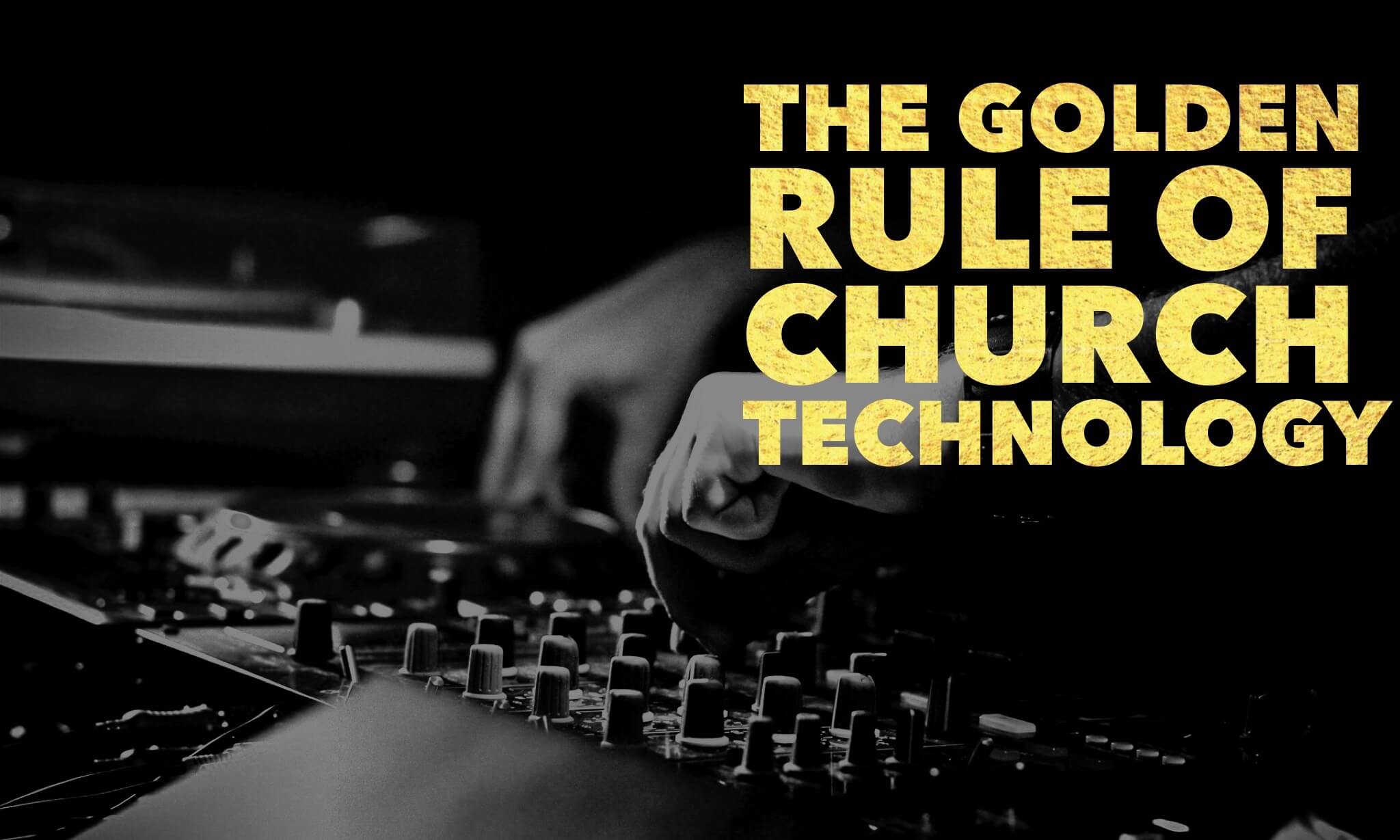The Golden Rule of Church Technology

In the grand scheme of Christian history, modern technology is still a recent addition. Not too long ago pastors did not have the luxury of sound systems, microphones, or projectors.
It’s hard to imagine what it would have been like to preach to large crowds in those days. While trying to project so all could hear, the strain on your voice must have been unbearable at times. Most pastors had a limit to how many people they could speak to because their voices would not carry far enough.
There were a few exceptions. George Whitfield, the 18th-century evangelist, had such a powerful voice that he was able to preach in the open air to crowds of up to twenty-five thousand people.
In fact, Benjamin Franklin wrote in his autobiography about how he believed the rumors of Whitefield’s voice to be impossible. So, being the scientific man that he was, Franklin performed an experiment. He went to listen to Whitfield preach and found that Whitefield was able to be heard over 500 feet away. Much to Franklin’s surprise, after doing the math and allowing two square feet per person in a semi-circle, he found the rumors were indeed true! In fact, Franklin calculated that Whitfield could even be heard by more than thirty thousand people.1 Wow! That man truly had a booming voice.
Fortunately today, we don’t all have to possess the lungs of Whitefield. We have microphones and powerful sound systems. Everyone can hear us with little vocal strain. We also have audio and video recording capabilities so people no longer even have to be in the room to hear us preach. Anyone, anywhere, at anytime can hear our sermons if we post them online.
But while modern technology is a powerful tool, it can also make things more complicated. Technology is always changing. Entire books could be written on the best use of technology in preaching, but they would be outdated within a year.
The Golden Rule of Church Tech
The single, overarching principle for technology in preaching is this: technology should add clarity, not distraction.
We’ve all seen what happens when technology fails. Maybe you were preaching your guts out. The audience was leaning in. God was moving. Then, it happened. Faulty technology spoiled a great sermon.
It could have been many things:
- Feedback in the speakers.
- Popping sounds from the microphone.
- The microphone battery died.
- The projector inexplicably shut off.
- The building lost power.
- The worship team’s new smoke machines triggered the fire alarms.
Yes, all these and more have happened to me, and the list could go on.
I once preached a sermon that I thought was one of my best yet. But I was horrified watching the recording. My mic popped and hissed throughout the entire message. It was distracting and embarrassing because I didn’t even realize it.
How many times has something like this happened to you?
When technology is at its best, it’s invisible, because it’s simply a tool to help deliver a clear message. But when technology is bad, it’s obvious. It distracts the audience and derails a good sermon.
Audio, lighting, and video are all tools to aid the clarity of the presentation. If at any time they become a distraction from God, either fix it or eliminate it.
Microphones
Today we have many options for preaching microphones. So when considering what microphone to use, you need to remember the primary technology principle and ask this question: Which microphone will help me preach with clarity while limiting distractions?
(For my recommendations on the best mics click here.)
Your microphone is one of your most essential tools. You will likely use one every time you preach, so you need to learn some best practices. To ensure limited distraction, here are a few tips you should consider:
- Have a backup wireless mic, just in case. It’s faster to switch than changing the batteries while everyone stares at you.
- Use new batteries every week. If you’re using rechargeable batteries to save money, change them before every service.
- Have an extra headset cable, just in case. In my experience, the cable that runs from a headset microphone down your back to the wireless battery pack is the first thing to break.
- Adjust the mic and do a sound check on stage before the service. Then, don’t touch it during it unless there’s a noticeable problem.
- If you have trouble with a headset microphone moving around on your ear, try using some clear, first aid tape behind your ear to help secure it in place.
Finally, when a mic goes bad, pause and acknowledge it. Apologize. Joke about it. Fix it fast. Then, move on.
I was at a conference recently listening to a nationally renowned preacher. In the middle of his talk, he knocked the headset mic off his ear. It was a distraction, but he handled it beautifully. He paused, fiddled with it for a moment, and quickly recovered by joking, “Whoops. I got a little too excited.” Everyone laughed, and he jumped right back into his message.
Don’t let the microphone get in the way of the message. Your sermon is too important to be derailed by technical difficulties. Take necessary precautions, train your volunteers, test everything, and invest in the right equipment.
Lighting
Pastors don’t often think about lighting, but it’s important. If the stage is too dark, people will not be able to see your face. People will be less engaged with your expressions, and more likely to get sleepy.
Calvin Miller says the worst thing about poorly lit preaching is that “people need to be able to see the passion, the body language, and the drama of what they attend. Great words spoken in darkness quickly become invisible as well as inaudible.”2
A sermon is most effective when the preacher’s face and eyes are visible. Therefore, to add clarity to and eliminate distractions, there are a few principles you need to know about lighting.
Many churches make the mistake of having lights directly over the preacher’s head. But lights over the pastor’s head cast shadows on their face under the eye sockets and nose. So their face is dark, and their eyes are hidden from the audience. The same effect can also come from spotlights in front of the stage at too high of an angle.
Some churches remedy this problem with a direct spotlight in the preacher’s eyes. It provides a well-lit face and the reflection of light you want to see in their eyes. But although this looks great to the audience, you don’t want to blind the pastor. Direct spotlights can be painful.
So the ideal setup has two lights, one to the left and one to the right side of the preacher at a 45-degree angle. It’s easier on the eyes and allows the light to be fixed at a lower angle without blinding them. And you still get a well-lit face and a glimmer of light in the pastor’s eyes.
Aside from the stage lights, you also need to think about the house lights—the lights shining on the audience. Many worship leaders like the house lights dimmed while singing. But preaching is different.
You want to see the faces of your audience so you can read them and make eye contact. It also allows people to see while taking notes, following along in their Bible, or using a Bible app on their phone without distracting everyone with the glow of the screen. So find a good level to bring up the house lights during your sermon.
Video
Years ago, I was a pastor at a large, multi-site church in New Mexico. We had a movie-theater-sized screen behind the pastor that displayed the sermon series art our graphic design team created.
Normally, it was great. It set the mood for the series and provided a backdrop to the sermon video that we sent to our video campuses. But one week we were in a series that had an underwater theme. The design team had outdone themselves creating a computer-animated, moving, underwater scene. Picture the landscape from the movie Finding Nemo. It was beautiful.
Unfortunately, the video became a big distraction. A large, orange fish swam endlessly around and behind the preacher’s head. I’m sure the sermon was great, but I only remember the fish.
Video screens are now common in churches. They used to be rare, but as technology has improved and prices have decreased, they’re almost expected. They are a powerful tool for illustrating your sermon with Bible verses, pictures, sermon graphics, and videos. But as wonderful as screens are, like all technology, they can either add clarity to your message or be a huge distraction.
Once again, you need to apply the primary technology principle. In everything you put on the screens, ask: does this add clarity or distraction?
Clarity, Not Distraction
If you have more technical questions about church audio, video, or lighting, there are many great websites and church technology experts that would be better suited to help you with technical questions.
Concerning your preaching, I simply want you to remember and apply the number one principle for technology: Technology should add clarity, not distraction.
Do everything you can to present a clear message using the technology available to you, but do not allow it to become a distraction.
Think ahead about all the things that could go wrong with your technology and have safeguards and backup procedures in place for when it fails you.
And don’t allow yourself to get distracted by all the lights and buttons of the latest gizmo. At the end of the day, technology is simply a tool to help you present the gospel more clearly.
This article has been adapted from a chapter in my book Preach and Deliver. For more tips to improve your preaching, click here to get a copy today.
- Benjamin Franklin, The Autobiography of Benjamin Franklin (Boston: Houghton, Mifflin and Company, 1888), 135
- Calvin Miller, Preaching: The Art of Narrative Exposition (Grand Rapids: Baker, 2006), 192



